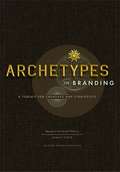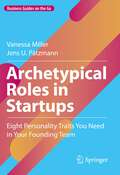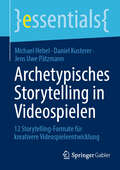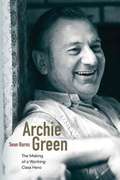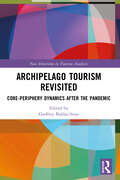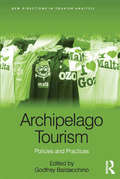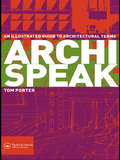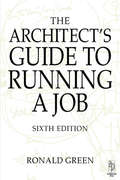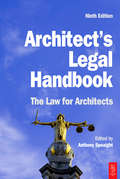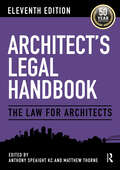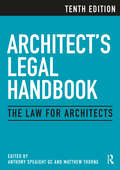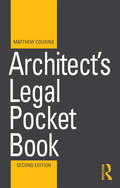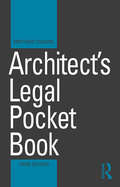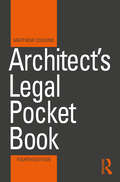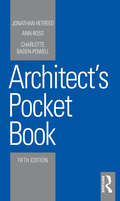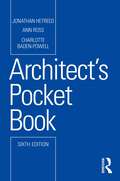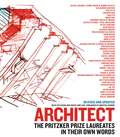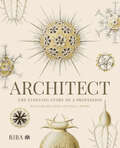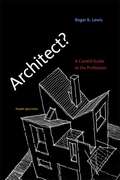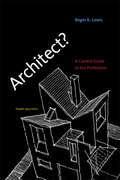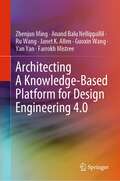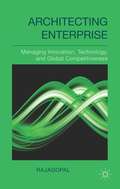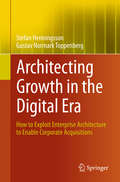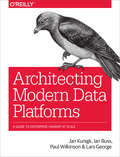- Table View
- List View
Archetypes in Branding
by Joshua C. Chen Margaret HartwellCommunication. Authenticity. Creativity. Tomorrow's brands will be defined by their interactions and relationships. Customers are demanding greater accountability from businesses. Workers are craving a deeper sense of meaning from their careers. And companies are continually seeking ways to achieve more powerful and resonant brand engagements. Archetypes in Branding: A Toolkit for Creatives and Strategists offers a practical tool for satisfying these needs. Using a highly participatory approach to brand development, and combined with a companion deck of sixty original archetype cards, this kit gives you the tools you need to: Reveal your brand's motivations, how it moves in the world, what its trigger points are and why it attracts certain customers Forge relationships with the myriad stakeholders that affect your business Empower your team to access their creativity and innovate with integrity C.G. Jung describes archetypes as "pieces of life itself-images that are integrally connected to the individual by the bridge of emotions." Applying archetypes helps bridge the gap between the cognitive and intuitive sides of the brain and between internal and external business objectives. Archetypes in Branding takes you through a fascinating exploration of the important role archetypes have played in mythology and psychology-and now in business-to resolve brand inconsistencies and enhance trust with all stakeholders.
Archetypical Roles in Startups: Eight Personality Traits You Need in Your Founding Team (Business Guides on the Go)
by Vanessa Miller Jens U. PätzmannFounding a startup is a challenging endeavor that works best in a well-balanced team. Different thinking styles are needed throughout the founding journey. Archetypes are deeply engrained templates in the collective unconscious and can be used to reveal the hidden aspects of social interactions within teams. This book employs an archetypical personality test to uncover the eight most significant team roles needed in a startup: the leader, the mentor, the artist, the friend, the hero, the femme fatale, the rebel and the manager. The artist, for example, always finds unconventional solutions, the femme fatale attracts support for the idea, and the hero is undaunted in the face of setbacks. Archetypical roles can manifest in individuals or at the group level, and they can and should change throughout the journey. With the included personality test, this book offers entrepreneurs, investors and mentors alike a tool to improve the interpersonal processes in startup teams.
Archetypisches Storytelling in Videospielen: 12 Storytelling-Formate für kreativere Videospieleentwicklung (essentials)
by Jens Uwe Pätzmann Michael Hebel Daniel KustererVideospiele besitzen als interaktives Erzählmedium ein besonderes Potenzial. Eine starke Handlung fungiert heute oft als Basis für den Erfolg eines Videospiels und sollte daher ein wichtiger Bestandteil der gesamten Konzeption sein. Dieses essential hat 50 preisgekrönte, handlungsorientierte Videospiele der letzten beiden Dekaden auf archetypische Storytelling-Formate hin untersucht, welche die verschiedenen narrativen Strukturen und Elemente der Videospiele beschreiben und besonders häufig in erfolgreichen Videospielproduktionen eingesetzt werden.
Archie Green: The Making of a Working-Class Hero
by David Roediger Nick Spitzer Sean BurnsArchie Green: The Making of a Working-Class Hero celebrates one of the most revered folklorists and labor historians of the twentieth century. Devoted to understanding the diverse cultural customs of working people, Archie Green (1917-2009) tirelessly documented these traditions and educated the public about the place of workers' culture and music in American life. Doggedly lobbying Congress for support of the American Folklife Preservation Act of 1976, Green helped establish the American Folklife Center at the Library of Congress, a significant collection of images, recordings, and written accounts that preserve the myriad cultural productions of Americans. Capturing the many dimensions of Green's remarkably influential life and work, Sean Burns draws on extensive interviews with Green and his many collaborators to examine the intersections of radicalism, folklore, labor history, and worker culture with Green's work. Burns closely analyzes Green's political genealogy and activist trajectory while illustrating how he worked to open up an independent political space on the American Left that was defined by an unwavering commitment to cultural pluralism.
Archipelago Tourism Revisited: Core-Periphery Dynamics after the Pandemic (New Directions in Tourism Analysis)
by Godfrey BaldacchinoThis timely and innovative book explores the dynamics of inter-island/island-island tourism – also known as archipelago tourism – on the cusp of the post-pandemic epoch.Embellished with illustrative maps and diagrams, the volume examines what novel approaches have been developed, if at all, so as not to repeat past mistakes, and nurture a more sustainable, 'island tourism' business model. It looks at how the political-economic relationship between main and outer islands changed during the pandemic and, if so, whether this shift has had a bearing on current tourism policy. The book also explores how these and other changes are reflected in how: islands are branded; island destinations are marketed; and island transport logistics play out. An array of archipelagos of varying sizes and locations is explored, assuring a global perspective. The book furthers our understanding of core-periphery dynamics in archipelago tourism.The volume will be of interest to students, researchers, policy makers and academics in the fields of tourism policy and planning, sustainability, island studies and development studies.
Archipelago Tourism: Policies and Practices (New Directions in Tourism Analysis)
by Godfrey BaldacchinoExploring the conceptual insights provided by the archipelagic 'twist' in the context of tourism principles, policies and practices, this volume draws on an international series of case studies to analyse best practice in branding, marketing and logistics in archipelago tourist destinations. The book asks and seeks to answer such questions as: How to 'sell' a multi-island destination, without risking a message that may be too complex and diffuse for audiences to grab on to? Does one encourage visitors to do 'island hopping'; and, if so, how and with what logistic facilities? How does one ascribe specific island destinations within an overall archipelago brand? Would smaller islands rebel against a composite branding strategy that actually benefits other islands? How does one read or craft transport policies as a function of the 'reterritorialisation' of a multi-island space? This book pioneers the exploration of the archipelago as tourism study focus (and not just locus); a heuristic device for rendering islands as sites of different tourism practices, industries and policies, but also of challenges and possibilities.
Archispeak: An Illustrated Guide to Architectural Terms
by Tom PorterWidely used in architectural circles in the heat of discussion, the recurrent use of particular words and terms has evolved into a language of design jargon. Commonly found in architectural literature and journalism, in critical design debate and especially in student project reviews, Archispeak can seem insular and perplexing to others and -- particularly to the new architectural student -- often incomprehensible.There is a need to translate architectural design concepts into spoken and written commentary -- each word in use embodying a precise and universally accepted architectural meaning. If we explore the vocabulary of this language we gain insight into good design practice and into collective understanding of what constitutes a refined architecture. This unique illustrated guide will help students understand the nuances of this specialized language and help them in communicating their own design ideas.
Architect's Guide to Running a Job
by Ronald GreenBest practice is the concern of this book. An architect has to be an administrator as well as designer, and smooth economical administration will provide the conditions under which client relations can be constructive and good design can be acheived.The book is divided into 76 short sections covering the entire process, from preliminary enquiries to final fees, each with a small flow chart showing who is involved and when. This sixth revised edition updates the contents in line with present day practice, bearing in mind the changes in terminology, technology, environmental demands and the legislative background.Ronald Green and Professor Ross Jamieson who writes the foreword to this edition, are both examiners for Part Three.
Architect's Legal Handbook: The Law For Architects (Architectural Press Legal Guides)
by Anthony SpeaightArchitect's Legal Handbook is the most widely used reference on the law for architects in practice, and the established leading textbook on law for architectural students. The ninth edition includes all the latest development in the law that affect an architect’s work, and comprehensive coverage of relevant UK law topics. Most significantly, the chapter on the JCT contracts has been completely revised to cover the 2005 update. Contributions by the foremost legal and architectural experts in the UK Full coverage of the JCT 2005 update New chapter on procurement Selected bibliography provides useful references to further reading Tables of Cases, Statutes and Statutory Instruments provide full referencing for cited cases Architect’s Legal Handbook is the essential legal reference work for all architects and students of architecture.
Architect's Legal Handbook: The Law for Architects
by Anthony Speaight Matthew ThorneCelebrating 50 years since it was first published, the Architect’s Legal Handbook has been the most widely used reference on the law for practicing architects, and the established textbook on law for architectural students. Since the last edition of this book in 2021, unprecedented change has occurred in the construction sector. The withdrawal of the United Kingdom from the European Union has ushered in changes to legislation in a wide range of areas. The tragic fire at Grenfell Tower in June 2017 and the deficiencies in design, construction, and regulation within the sector that were revealed as a result have given rise to major changes in the way projects are now carried out. An overhaul of the Building Regulations and the creation of a new Building Safety Regulator are only some of the ways in which the landscape has changed. This eleventh edition features all the latest developments in the law which affect an architect’s work, as well as providing comprehensive coverage of relevant UK law topics. Key highlights of this edition include: A new chapter has been added to cover the statutory framework for building safety (Chapter 9), which is complemented by a wholly updated chapter on construction regulation in England and Wales (Chapter 10). The chapter on public procurement law (Chapter 14) has also been entirely rewritten to focus on the Public Procurement Act 2023 and related regulations, following Brexit. New suites of standard contract forms have, since the last edition, been issued. These have seen substantial changes with chapters on JCT 2024 (Chapter 18) and the latest NEC4 forms (Chapter 19), together with wider updates to the chapters on FIDIC (Chapter 20) and other forms of contract (Chapter 21). A revised chapter on architects’ contracts with clients covering the RIBA Professional Services Contract 2024 (Chapter 37). A new section on novations in the chapter on the English Law of Contract (Chapter 2). The Architect’s Legal Handbook is the essential legal reference work for all architects and students of architecture.
Architect's Legal Handbook: The Law for Architects
by Anthony Speaight QC and Matthew ThorneThe Architect's Legal Handbook is the most widely used reference on the law for practicing architects and the established textbook on law for architectural students. Since the last edition of this book in 2010, the legal landscape in which architecture is practised has changed significantly: the long-standing procurement model with an architect as contract administrator has been challenged by the growing popularity of design and build contracts, contract notices in place of certificates, and novation of architect’s duties. The tenth edition features all the latest developments in the law which affect an architect's work, as well as providing comprehensive coverage of relevant UK law topics. Key highlights of this edition include: an overview of the legal environment, including contract, tort, and land law; analysis of the statutory framework, including planning law, health and safety, construction legislation, and building regulations in the post-Grenfell legal landscape; procurement and the major industry construction contract forms; building dispute resolution, including litigation, arbitration, adjudication, and mediation; key fields for the architect in practice, including architects’ registration and professional conduct, contracts with clients and collateral warranties, liability in negligence, and insurance; entirely new chapters on various standard form contracts, architects’ responsibility for the work of others, disciplinary proceedings, and data protection; tables of cases, legislation, statutes, and statutory instruments give a full overview of references cited in the text. The Architect’s Legal Handbook is the essential legal reference work for all architects and students of architecture.
Architect's Legal Pocket Book (Routledge Pocket Books)
by Matthew CousinsA little book that's big on information, the Architect's Legal Pocket Book is the definitive reference on legal issues for architects and architectural students. This handy pocket guide covers key legal principles which will help you to quickly understand the law and where to go for further information. Now in a fully updated new edition, this bestselling book covers a wide range of subjects focused on the UK including building legislation, negligence, liability, planning policy and development, listed buildings, party wall legislation, and rights of light. This edition also contains greater coverage of contracts including the RIBA contracts, dispute resolution and legal issues in professional practice. Illustrated with clear diagrams and featuring key cases, this is an invaluable source of practical information and a comprehensive guide of the current law for architects. It is a book no architect should be without.
Architect's Legal Pocket Book (Routledge Pocket Books)
by Matthew CousinsA little book that’s big on information, the Architect’s Legal Pocket Book is the definitive reference guide on legal issues for architects and architectural students. This handy pocket guide covers key legal principles which will help you to quickly understand the law and where to go for further information. Now in its third edition, this bestselling book has been fully updated throughout to provide you with the most current information available. Subjects include contract administration, building legislation, planning, listed buildings, contract law, negligence, liability and dispute resolution. This edition also contains new cases and legislation, contracts including the RIBA contract administration certificates, inspection duties, practical completion, the Hackitt review, the Report of the Independent Inquiry into the Construction of Edinburgh Schools and practical issues facing architects. Illustrated with clear diagrams and featuring key cases, this is a comprehensive guide to current law for architects and an invaluable source of information. It is a book no architect should be without.
Architect's Legal Pocket Book (Routledge Pocket Books)
by Matthew CousinsA little book that is big on information, the Architect’s Legal Pocket Book is the definitive reference guide on legal issues for architects and architectural students. This handy pocket guide covers key legal principles which will help you to quickly understand the law and where to go for further information.Now in its fourth edition, this bestselling book has been fully updated throughout to provide you with the most current information available. Subjects include contract administration, building legislation, planning, listed buildings, contract law, negligence, liability and dispute resolution. This edition also contains new cases and legislation, building safety, contracts, inspection duties, practical completion and practical issues facing architects.Illustrated with clear diagrams and featuring key cases, this is a comprehensive guide to current law for architects and an invaluable source of information. It is a book no architect should be without.
Architect's Pocket Book (Routledge Pocket Books)
by Jonathan Hetreed Ann Ross Charlotte Baden-PowellThis handy pocket book brings together a wealth of useful information that architects need on a daily basis – on-site or in the studio. It provides clear guidance and invaluable detail on a wide range of issues, from planning policy through environmental design to complying with Building Regulations, from structural and services matters to materials characteristics and detailing. This fifth edition includes the updating of regulations, standards and sources across a wide range of topics. Compact and easy to use, the Architect’s Pocket Book has sold well over 90,000 copies to the nation’s architects, architecture students, designers and construction professionals who do not have an architectural background but need to understand the basics, fast. This is the famous little blue book that you can’t afford to be without.
Architect's Pocket Book (Routledge Pocket Books)
by Jonathan Hetreed Ann Ross Charlotte Baden-PowellThis handy pocket book brings together a wealth of useful information that architects need on a daily basis – on-site or in the studio. It provides clear guidance and invaluable detail on a wide range of issues, from planning policy through environmental design to complying with Building Regulations, from structural and services matters to materials characteristics and detailing. This sixth edition includes the updating of regulations, standards and sources across a wide range of topics, with a particular focus on sustainability issues. Compact and easy to use, the Architect’s Pocket Book has sold well over 100,000 copies to the nation’s architects, architecture students, designers and construction professionals who do not have an architectural background but need to understand the basics, fast. This is the famous little blue book that you can’t afford to be without.
Architect: The Pritzker Prize Laureates in Their Own Words
by Ruth Peltason Grace Ong YanIn this completely revised and up-to-date edition, the world's most accomplished architects-Gehry, Pei, Meier, Nouvel, Piano, and 37 more-express their views on creativity, inspiration, and legacy in this visually stunning, one-of-a-kind collection.The Pritzker Prize is the most prestigious international prize for architecture. Architect includes all 42 recipients of the Pritzker Prize, and captures in pictures and their own words their awe-inspiring achievements. Organized in reverse chronological order by laureate each chapter features four to six of the architect's major works, including museums, libraries, hotels, places of worship, and more. The text, culled from notebooks, interviews, articles, and speeches illuminates the architects' influences and inspirations, personal philosophy, and aspirations for his own work and the future of architecture. The book includes More than 1000 stunning photographs, blueprints, sketches, and CAD drawings.Architect offers an unprecedented view into the minds of some of the most creative thinkers, dreamers, and builders of the last three decades and reveals that buildings are political, emotional, and spiritual.
Architect: The evolving story of a profession
by Eleanor Jolliffe Paul CrosbyThe architect’s role is constantly adapting. Throughout history it has shifted significantly, shaped by social, cultural, technological and economic forces. The very definition of what an architect is and does has evolved over time from lead builder or master mason to principal designer. A collaborative and reactive profession, it is inextricably linked to the power of the patron, whether the client is an influential and affluent individual or a political, commercial, civic or religious organisation. From Ancient Egypt, where architects were members of the ruling class, tied into the running of the empire, to the 21st century when questions are being raised about the future of the profession, this book, with its engaging narrative, explores the constant threads that remain as the profession adapts. While architects are no longer deified, their ability to imagine a new impending reality in built form implies a visionary dimension to their work. By focusing on both the practicalities of the profession and the more intangible motivations behind design – humans’ need to make a mark upon their surroundings – this volume provides a critical overview of over 3000 years of practice and education. Looking at the key questions of where the architectural profession originated in the Western tradition, why it is, how it is today and where it might be going next, the authors postulate that architects’ ability to adapt and reinvent themselves in the past will stand them in good stead for the uncertainties of the future.
Architect?
by Roger K. LewisSince 1985, "Architect?" has been an essential text for aspiring architects, offering the best basic guide to the profession available. This third edition has been substantially revised and rewritten, with new material covering the latest developments in architectural and construction technologies, digital methodologies, new areas of focus in teaching and practice, evolving aesthetic philosophies, sustainability and green architecture, and alternatives to traditional practice. "Architect?" tells the inside story of architectural education and practice; it is realistic, unvarnished, and insightful. Chapter 1 asks "Why Be an Architect?" and chapter 2 offers reasons "Why Not to Be an Architect. " After this provocative beginning, Architect? goes on to explain and critique architectural education, covering admission, degree and curriculum types, and workload as well as such post-degree options as internship, teaching, and work in related fields. It offers a detailed discussion of professors and practitioners and the "-isms" and "-ologies" most prevalent in teaching and practicing architecture. It explains how an architect works and gets work, and describes architectural services from initial client contact to construction oversight. The new edition also includes a generous selection of drawings and cartoons from the authors Washington Post column, "Shaping the City," offering teachable moments wittily in graphic form. The author, Roger Lewis, has taught, practiced, and written extensively about architecture for many years. In "Architect?" he explains -- for students, professors, practitioners, and even prospective clients -- how architects think and work and what they care about as they strive to make the built environment more commodious, more beautiful, and more sustainable.
Architect?, third edition: A Candid Guide to the Profession (The\mit Press Ser.)
by Roger K. LewisThe new edition of an essential text offers an informative, engaging view of the architectural profession from education through practice.Since 1985, Architect? has been an essential text for aspiring architects, offering the best basic guide to the profession available. This third edition has been substantially revised and rewritten, with new material covering the latest developments in architectural and construction technologies, digital methodologies, new areas of focus in teaching and practice, evolving aesthetic philosophies, sustainability and green architecture, and alternatives to traditional practice. Architect? tells the inside story of architectural education and practice; it is realistic, unvarnished, and insightful. Chapter 1 asks “Why Be an Architect?” and chapter 2 offers reasons “Why Not to Be an Architect.” After this provocative beginning, Architect? goes on to explain and critique architectural education, covering admission, degree and curriculum types, and workload as well as such post-degree options as internship, teaching, and work in related fields. It offers a detailed discussion of professors and practitioners and the “-isms” and “-ologies” most prevalent in teaching and practicing architecture. It explains how an architect works and gets work, and describes architectural services from initial client contact to construction oversight. The new edition also includes a generous selection of drawings and cartoons from the author's Washington Post column, “Shaping the City,” offering teachable moments wittily in graphic form.The author, Roger Lewis, has taught, practiced, and written extensively about architecture for many years. In Architect? he explains—for students, professors, practitioners, and even prospective clients—how architects think and work and what they care about as they strive to make the built environment more commodious, more beautiful, and more sustainable.
Architecting A Knowledge-Based Platform for Design Engineering 4.0
by Janet K. Allen Farrokh Mistree Anand Balu Nellippallil Yan Yan Zhenjun Ming Ru Wang Guoxin Wang"Design Engineering for Industry 4.0 (DE4.0) represents the 'human-cyber-physical view of the systems realization ecosystem “that is necessary to accommodate the drivers of Industry 4.0 (IoX) and provide an open ecosystem for the realization of complex systems. Seamless integration of digital threads and digital twins throughout the product design, the development and fulfillment lifecycle; the ability to accommodate diverse and rapidly changing technologies; and the mechanisms to facilitate the creation of new opportunities for the design of products, processes, services, and systems are some of the desired characteristics of DE4.0."Jiao, R., Commuri, S. Panchal, J., Milisavljevic-Syed, J, Allen, J.K., Mistree, F. and Schaefer, D., "Design Engineering in the Age of Industry 4.0," ASME Journal of Mechanical Design, 143(7), 070801, 25 pages.In keeping with the Design Engineering 4.0 construct the authors describe architecting a computer platform to support human designers make decisions associated with the realization of complex engineered systems. The platform is designed to facilitate end-to-end digital integration, customization and personalization, agile collaboration networks, open innovation, co-creation and crowdsourcing, product servitization and anything-as-a-service.Recognizing that simulation models are abstractions of reality the authors opt for a satisficing strategy instead of an optimization strategy. They include fundamentals and then describe tools for architecting a knowledge-based platforms for decision support. Challenges associated with developing a computational platform for decision support for the realization of complex engineered systems in the context of Design Engineering 4.0 are identified. Constructs for formulating design decisions (e.g., selection, compromise, and coupled decisions), knowledge modelling schemes (e.g., ontologies and modular templates), diagrams for designing decision workflows (e.g., the PEI-X diagram), and some analytical methods for robust design under uncertainty are presented. The authors describe integrating the knowledge-based platform to architect a cloud-based platform for decision support promoting co-design and cloud-based design communication essential for mass collaboration and open innovation for Design Engineering 4.0.This book is a valuable resource for researchers, design engineers, and others working on pushing the boundary of digitized manufacturing to include Design Engineering 4.0 principles in designing products, processes, and services.
Architecting Enterprise
by RajagopalThe discussion in this book provides an introduction to the concept of entrepreneurship and entrepreneurial business management. The author covers many elements of the entrepreneurial management discipline including choosing a business, organizing, financing, marketing, developing an offering that the market will value, and growing a business.
Architecting Fail‐Safe Supply Networks
by Jitesh H. Panchal Shabnam Rezapour Amirhossein Khosrojerdi Golnoosh Rasoulifar Janet K. Allen Ramakrishnan S. Srinivasan Jeffrey D. Tew Farrokh MistreeA fail-safe supply network is designed to mitigate the impact of variations and disruptions on people and corporations. This is achieved by (1) developing a network structure to mitigate the impact of disruptions that distort the network structure and (2) planning flow through the network to neutralize the effects of variations. In this monograph, we propose a framework, develop mathematical models and provide examples of fail-safe supply network design. We show that, contrary to current thinking as embodied in the supply network literature, disruption management decisions made at the strategic network design level are not independent from variation management decisions made at the operational level. Accordingly, we suggest that it is beneficial to manage disruptions and variations concurrently in supply networks. This is achieved by architecting fail-safe supply networks, which are characterized by the following elements: reliability, robustness, flexibility, structural controllability, and resilience. Organizations can use the framework presented in this monograph to manage variations and disruptions. Managers can select the best operational management strategies for their supply networks considering variations in supply and demand, and identify the best network restoration strategies including facility fortification, backup inventory, flexible production capacity, flexible inventory, and transportation route reconfiguration. The framework is generalizable to other complex engineered networks.
Architecting Growth in the Digital Era: How to Exploit Enterprise Architecture to Enable Corporate Acquisitions
by Stefan Henningsson Gustav Normark ToppenbergThis book provides the reader with the cognitive keys and practical guidelines to manage acquisitive growth in the digital era. It takes a distinct managerial perspective on acquisitions, with a relentless focus on how Enterprise Architecture (EA) relates to value creation. The book builds upon an extensive fundament of rigorous research, first-hand experiences from using Enterprise Architecture to catalyze acquisitions in several Fortune 500 companies, and a wide pool of case examples from leading firms in the US, Europe and Australia.The book is divided into three parts. Part I addresses the fundament for the book by decomposing the problem of acquisitive growth and explaining how advance in EA practices have created the potential for mitigating the challenges. Part II then details how an advanced EA capability can contribute to the different phases of an acquisition process. Lastly, Part III provides hands-on guidance on how to implement EA in the acquisition process and concludes with a summary and personal advice from the authors as notes on the journey ahead.Overall, this book explains how Enterprise Architecture can be used to unlock the value potential in acquisitions without bringing the need for a major organizational restructure. It provides managers, EA professionals, and MBA students with the cognitive keys to characterize the problems and to craft and implement effective solutions.
Architecting Modern Data Platforms: A Guide to Enterprise Hadoop at Scale
by Paul Wilkinson Lars George Jan Kunigk Ian BussThere’s a lot of information about big data technologies, but splicing these technologies into an end-to-end enterprise data platform is a daunting task not widely covered. With this practical book, you’ll learn how to build big data infrastructure both on-premises and in the cloud and successfully architect a modern data platform.Ideal for enterprise architects, IT managers, application architects, and data engineers, this book shows you how to overcome the many challenges that emerge during Hadoop projects. You’ll explore the vast landscape of tools available in the Hadoop and big data realm in a thorough technical primer before diving into:Infrastructure: Look at all component layers in a modern data platform, from the server to the data center, to establish a solid foundation for data in your enterprisePlatform: Understand aspects of deployment, operation, security, high availability, and disaster recovery, along with everything you need to know to integrate your platform with the rest of your enterprise ITTaking Hadoop to the cloud: Learn the important architectural aspects of running a big data platform in the cloud while maintaining enterprise security and high availability
